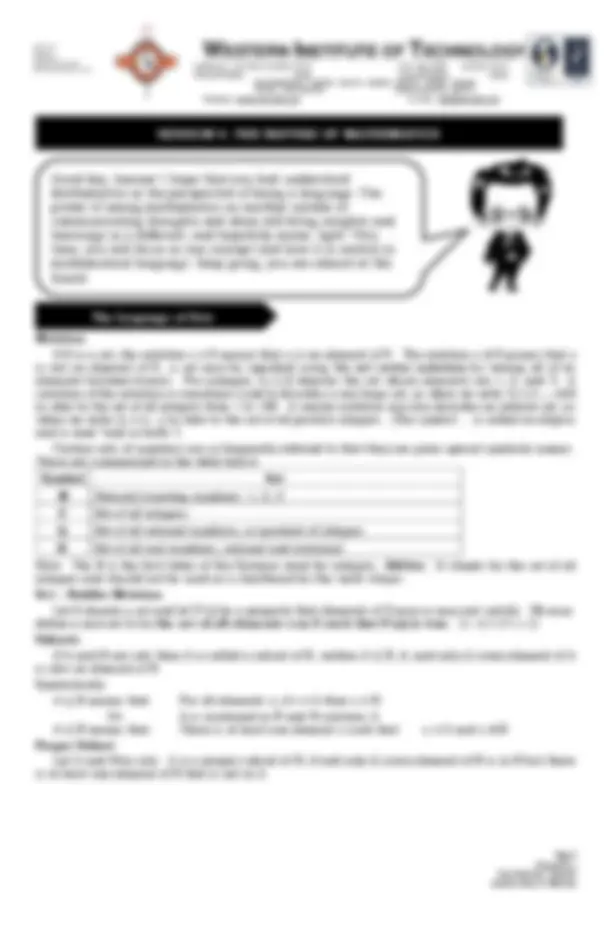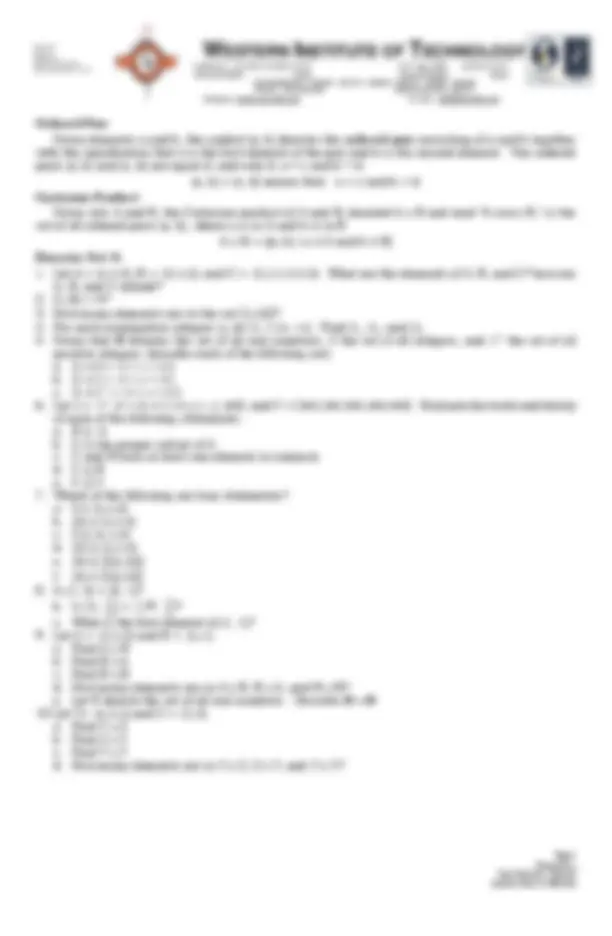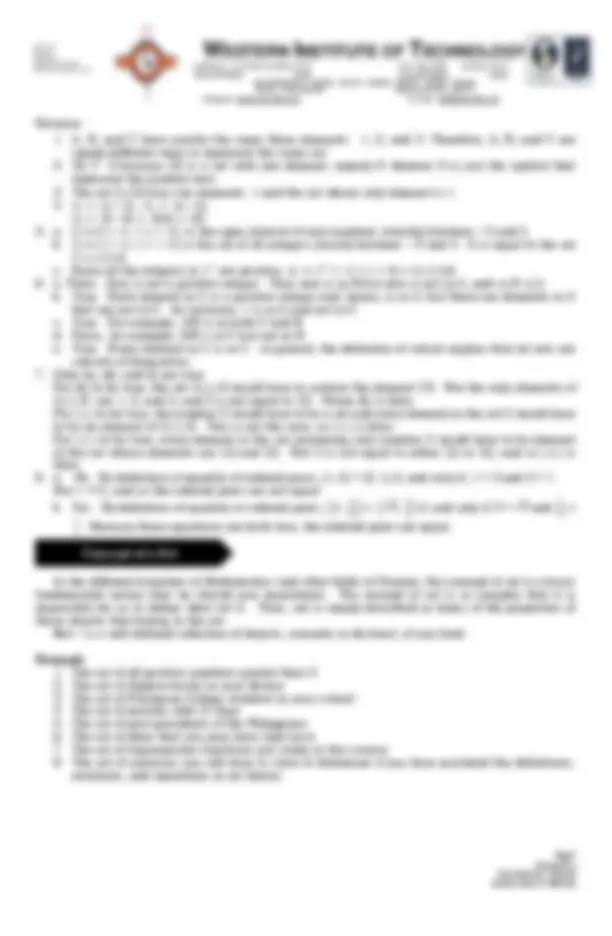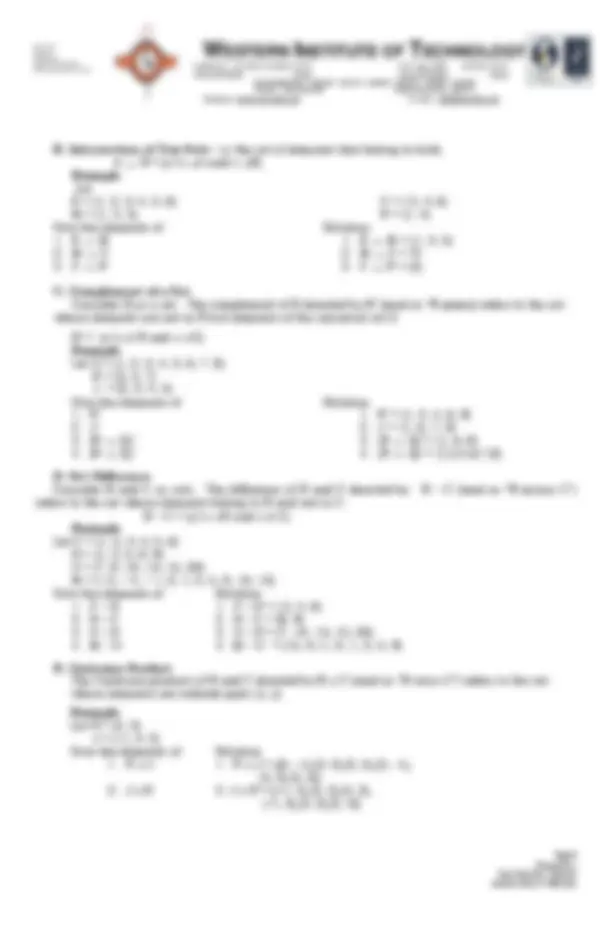







Study with the several resources on Docsity

Earn points by helping other students or get them with a premium plan


Prepare for your exams
Study with the several resources on Docsity

Earn points to download
Earn points by helping other students or get them with a premium plan
Community
Ask the community for help and clear up your study doubts
Discover the best universities in your country according to Docsity users
Free resources
Download our free guides on studying techniques, anxiety management strategies, and thesis advice from Docsity tutors
A set of lecture notes from a Mathematics in the Modern World course at the Western Institute of Technology in the Philippines. The notes cover the topics of set theory, including the definitions and examples of union, intersection, and difference of sets. The notes also include exercises for students to practice these concepts.
Typology: Lecture notes
1 / 9

This page cannot be seen from the preview
Don't miss anything!






LUNA ST., LA PAZ, ILOILO CITY P.O. Box 258 ILOILO CITY
PHILIPPINES 5000 PHILIPPINES 5000
TELEPHONE Nos.: 3200259 3201475 3200902 3209767 3209853 3209456
FAX No. +6333 3201484 Globe-Islacom No. 5087151
Website: www.wit.edu.ph E-mail: wit@wit.edu.ph
Page 1
Prepared by:
Prof. Ninfa Sua – Sotomil
Issue: 2
Revision: 0
Approved: President
Date: November 24, 2014
WESTERN INSTITUTE OF TECHNOLOGY
LUNA ST., LA PAZ, ILOILO CITY P.O. Box 258 ILOILO CITY
PHILIPPINES 5000 PHILIPPINES 5000
TELEPHONE Nos.: 3200259 3201475 3200902 3209767 3209853 3209456
FAX No. +6333 3201484 Globe-Islacom No. 5087151
Website: www.wit.edu.ph E-mail: wit@wit.edu.ph
Page 2
Prepared by:
Prof. Ninfa Sua – Sotomil
Issue: 2
Revision: 0
Approved: President
Date: November 24, 2014
Course Number : Math 1
Course Title : Mathematics in the Modern World
Course Description : This course deals with the nature of mathematics, appreciation of its practical
and intellectual and aesthetic dimensions, and application of mathematical tools in
daily life.
The course begins with an introduction to the nature of mathematics as an
exploration of pattern (in nature and the environment) and as an application of
inductive and deductive reasoning. By exploring these topics, students are
encouraged to go beyond the typical understanding of mathematics as merely a set
of formulas but as a source of aesthetics in patterns of nature, for example, and a
rich language in itself (and of science) governed by logic and reasoning.
The course then proceeds to survey ways in which mathematics provide a tool for
understanding and dealing with various aspects of present – day living, such as
managing personal finances, making social choices, appreciating geometric designs,
understanding codes used in data transmission and security, and dividing limited
resources fairly. These aspects will provide opportunities for actually doing
mathematics in a broad range of exercises
Pre-requisite : None
Credit Units : 3 Units
Course Outline
Section I. The Nature of Mathematics
References:
CHED Memorandum Order No. 20, series of 2013. (4 July 2013). General Education Curriculum:
Holistic understandings, intellectual and civic competencies
Nocon R. et al. (2018). Essential Mathematics for the Modern World. Quezon City: C & E Publishing,
Inc.
WESTERN INSTITUTE OF TECHNOLOGY
LUNA ST., LA PAZ, ILOILO CITY P.O. Box 258 ILOILO CITY
PHILIPPINES 5000 PHILIPPINES 5000
TELEPHONE Nos.: 3200259 3201475 3200902 3209767 3209853 3209456
FAX No. +6333 3201484 Globe-Islacom No. 5087151
Website: www.wit.edu.ph E-mail: wit@wit.edu.ph
Page 4
Prepared by:
Prof. Ninfa Sua – Sotomil
Issue: 2
Revision: 0
Approved: President
Date: November 24, 2014
Ordered Pair
Given elements a and b, the symbol (a, b) denotes the ordered pair consisting of a and b together
with the specification that a is the first element of the pair and b is the second element. Two ordered
pairs (a, b) and (c, d) are equal if, and only if, a = c and b = d.
(a, b) = (c, d) means that a = c and b = d
Cartesian Product
Given sets A and B, the Cartesian product of A and B, denoted A x B and read “A cross B,” is the
set of all ordered pairs (a, b), where a is in A and b is in B.
A x B = {(a, b) ∣ a ∈ A and b ∈ B}
Exercise Set 4:
A, B, and C related?
𝑛
= {𝑛, −𝑛}. Find 𝑈
1
2
, and 𝑈
0
the set of all
positive integers, describe each of the following sets.
a.
b.
c.
, 𝐵 = {𝑛 ∈ 𝑍 ∣ 0 ≤ 𝑛 ≤ 100 }, and C = { 100 , 200 , 300 , 400 , 500 }. Evaluate the truth and falsity
of each of the following statements.
a. B ⊆ A
b. C is the proper subset of A
c. C and B have at least one element in common
d. C ⊆ B
e. C ⊆ C
a. 2 ∈ { 1 , 2 , 3 }
b. { 2 } ∈ { 1 , 2 , 3 }
c. 2 ⊆ { 1 , 2 , 3 }
d. { 2 } ⊆ { 1 , 2 , 3 }
e. { 2 } ⊆ {{ 1 }, { 2 }}
f. { 2 } ∈ {{ 1 }, { 2 }}
b. Is ( 3 ,
5
10
1
2
c. What is the first element of (1, 1)?
a. Find A x B
b. Find B x A
c. Find B x B
d. How many elements are in A x B, B x A, and B x B?
e. Let R denote the set of all real numbers. Describe R x R
a. Find Y x Z
b. Find Z x Y
c. Find Y x Y
d. How many elements are in Y x Z, Z x Y, and Y x Y?
WESTERN INSTITUTE OF TECHNOLOGY
LUNA ST., LA PAZ, ILOILO CITY P.O. Box 258 ILOILO CITY
PHILIPPINES 5000 PHILIPPINES 5000
TELEPHONE Nos.: 3200259 3201475 3200902 3209767 3209853 3209456
FAX No. +6333 3201484 Globe-Islacom No. 5087151
Website: www.wit.edu.ph E-mail: wit@wit.edu.ph
Page 5
Prepared by:
Prof. Ninfa Sua – Sotomil
Issue: 2
Revision: 0
Approved: President
Date: November 24, 2014
Concept of a Set
Solution
simply different ways to represent the same set.
≠ 0 because
is a set with one element, namely 0 whereas 0 is just the symbol that
represent the number zero.
} has two elements: 1 and the set whose only element is 1.
1
2
0
b. { 𝑥 ∈ 𝑍 ∣ − 2 , < 𝑥 < 5 } is the set of all integers (strictly between − 2 and 5. It is equal to the set
c. Since all the integers in 𝑍
are positive, {𝑥 ∈ 𝑍
b. True. Each element in C is a positive integer and, hence, is in A, but there are elements in A
that are not in C. for instance, 1 is in A and not in C.
c. True. For example, 100 is in both C and B.
d. False, for example, 200 s in C but not in B.
e. True. Every element in C is in C. in general, the definition of subset implies that all sets are
subsets of themselves.
For (b) to be true, the set
would have to contain the element
. But the only elements of
{ 1 , 2 , 3 } are 1, 2, and 3, and 2 is not equal to { 2 }. Hence (b) is false.
For ( c ) to be true, the number 2 would have to be a set and every element in the set 2 would have
to be an element of { 1 , 2 , 3 }. This is not the case, so ( c ) is false.
For ( c ) to be true, every element in the set containing only number 2 would have to be element
of the set whose elements are { 1 } and { 2 }. But 2 is not equal to either { 1 } or { 2 }, and so ( e ) is
false.
But 1 ≠ 2, and so the ordered pairs are not equal.
b. Yes. By definition of equality or ordered pairs, ( 3 ,
5
10
1
2
) if, and only if 3 = √
9 and
5
10
1
2
. Because these equations are both true, the ordered pairs are equal.
In the different branches of Mathematics and other fields of Science, the concept of set is a basic
fundamental notion that we should give importance. The concept of set is so complex that it is
impossible for us to define what set is. Thus, set is simply described in terms of the properties of
those objects that belong to the set.
Set – is a well–defined collection of objects, concrete or abstract, of any kind.
Example
notations, and operations in set theory
WESTERN INSTITUTE OF TECHNOLOGY
LUNA ST., LA PAZ, ILOILO CITY P.O. Box 258 ILOILO CITY
PHILIPPINES 5000 PHILIPPINES 5000
TELEPHONE Nos.: 3200259 3201475 3200902 3209767 3209853 3209456
FAX No. +6333 3201484 Globe-Islacom No. 5087151
Website: www.wit.edu.ph E-mail: wit@wit.edu.ph
Page 7
Prepared by:
Prof. Ninfa Sua – Sotomil
Issue: 2
Revision: 0
Approved: President
Date: November 24, 2014
Operations on Sets
4. Empty or Null Set – a set with no element
Example C = { }
D = { xx is an integer less than 12 but greater than 11}
5. Universal Set – the totality of elements of a set under consideration
Example R = { xx is a partial scholar in the university}
E = { xx is a planet in the solar system}
6. Subset – a set whose elements are members of a given set
Given sets A and B, if all the elements of set A are found in B, then A is a subset of B.
Example A = {1, 3, 5, 7, 9}
7. Equal Sets – Sets A and B are equal if and only if all the elements of set A are in set B, and all
the elements of B are in A.
Example A = {M, o, n}
B = {n, o, M}
Then A = B
8. Equivalent Sets – sets where one–to–one correspondence between the elements of sets A and
B exists. A one–to–one correspondence exists between two sets A and B, if we
can pair an element of A with exactly one element of B.
Example A = {1, 3, 5, 7}
B = {e, y, m, z}
9. Disjoint Sets – sets that have no common elements
Example C = {1, 2, 3, 4, 5,}
Thus we can conclude that C and D are disjoint sets.
A. Union of Two Sets – is a set in which the elements of the two sets are combined. If the two
sets have elements in common such elements are written only once.
A B = {x x A or x B}
Example
Let
Give the elements of
Solution:
of E. Hence,
Based on the above examples, we have discovered that some of the elements of the union are
elements of both sets. But, in tabulating the elements of the union of the sets, elements common to
both are just listed once.
WESTERN INSTITUTE OF TECHNOLOGY
LUNA ST., LA PAZ, ILOILO CITY P.O. Box 258 ILOILO CITY
PHILIPPINES 5000 PHILIPPINES 5000
TELEPHONE Nos.: 3200259 3201475 3200902 3209767 3209853 3209456
FAX No. +6333 3201484 Globe-Islacom No. 5087151
Website: www.wit.edu.ph E-mail: wit@wit.edu.ph
Page 8
Prepared by:
Prof. Ninfa Sua – Sotomil
Issue: 2
Revision: 0
Approved: President
Date: November 24, 2014
B. Intersection of Two Sets – is the set of elements that belong to both.
B = {x x
A and x
Example
Let
Give the elements of
Solution:
C. Complement of a Set
Consider B as a set. The complement of B denoted by B’ (read as “B prime) refers to the set
whose elements are not in B but elements of the universal set U.
B’ = {x x B and x U}
Example
Let U = {1, 2, 3, 4, 5, 6, 7, 8}
Give the elements of
Solution
D. Set Difference
Consider B and C as sets. The difference of B and C denoted by B – C (read as “B minus C”)
refers to the set whose elements belong to B and not in C.
B – C = {x x B and x C}
Example
Let C = {1, 2, 3, 4, 5, 6}
Give the elements of Solution
E. Cartesian Product
The Cartesian product of B and C denoted by B x C (read as “B cross C”) refers to the set
whose elements are ordered pairs (x, y)
Example
Let R = {2, 3}
Give the elements of Solution